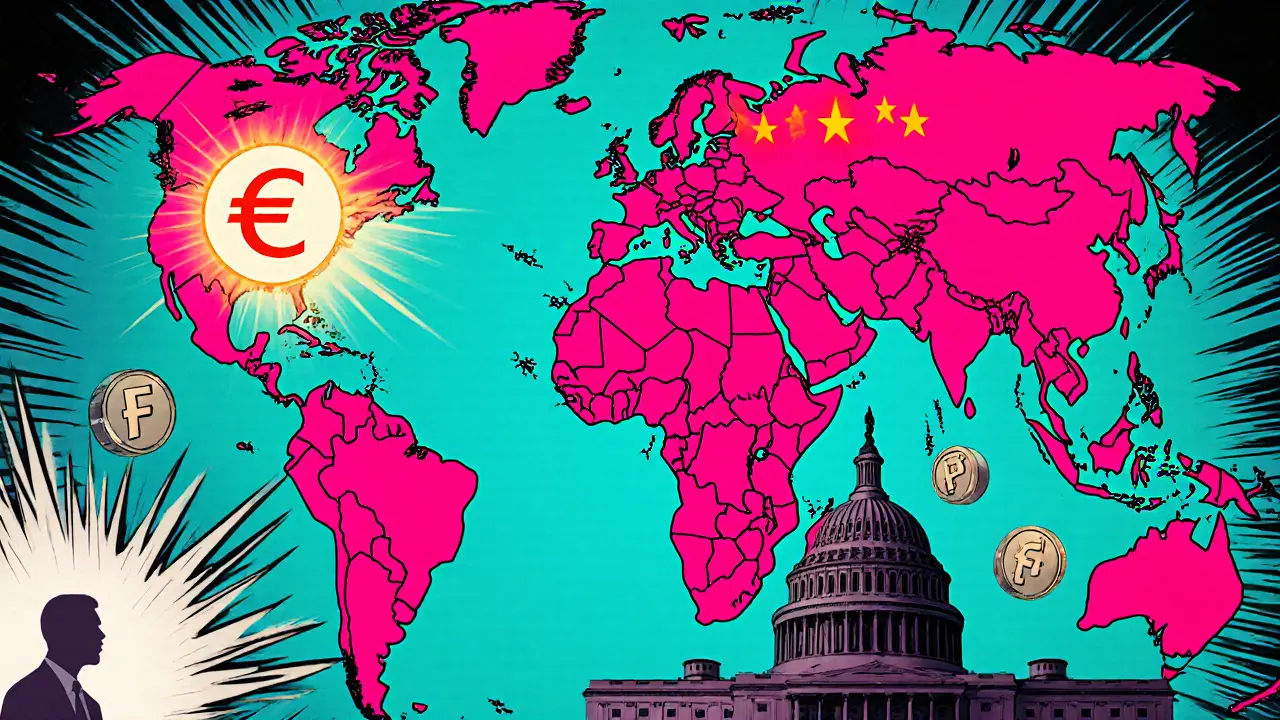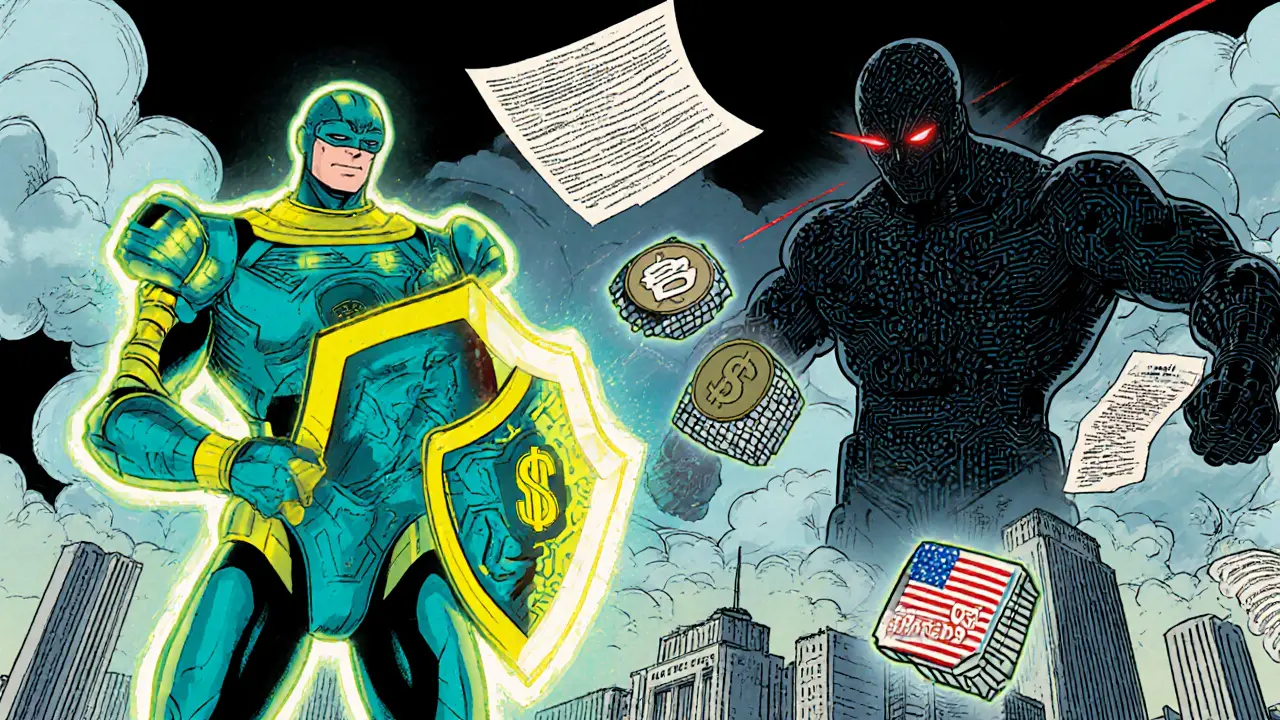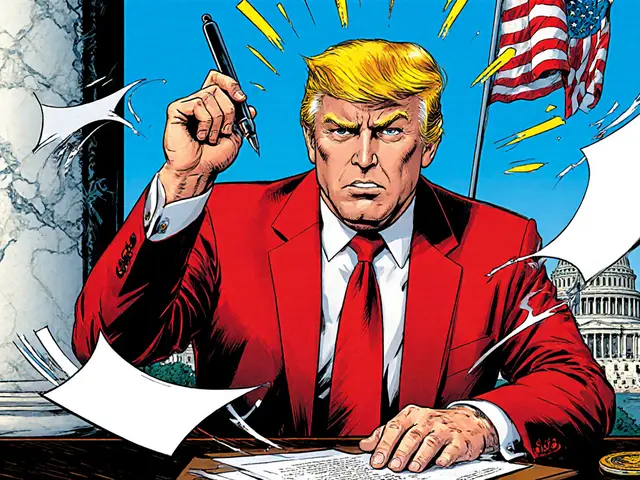US CBDC Policy Impact Simulator
Simulation Results
Enter your policy preference and time horizon, then click Simulate Impact to see projected outcomes.
Global CBDC Adoption Rate:
US Position:
Private Sector Projects:
Transaction Volume (2025):
TL;DR
- Executive Order 14178 signed by President Donald Trump ends all US government work on a digital dollar (FedCoin).
- The Federal Reserve, led by Jerome Powell, now rules out any CBDC while he remains chair.
- Globally, 134 countries are still pushing ahead - the US is now the odd one out.
- Private‑sector projects like Fnality aim to fill the gap left by the policy reversal.
- The halt raises questions about US competitiveness, financial‑surveillance concerns, and future regulation of stablecoins.
What the US Was Doing Before the Halt
US CBDC is a central bank digital currency initiative that the United States was researching before being halted by Executive Order 14178 under the Biden administration. In 2022 President Joe Biden issued Executive Order 14067, calling for “the highest urgency” in exploring a digital dollar, often referred to as FedCoin. The Federal Reserve set up multiple pilots, testing everything from retail‑use prototypes to wholesale settlement on distributed‑ledger technology.
To coordinate the effort, the Treasury launched an inter‑agency working group in March 2023. Treasury Inter‑Agency Working Group brought together officials from the Treasury, Federal Reserve, White House, Council of Economic Advisors, National Economic Council, National Security Council, and Office of Science and Technology Policy to shape design choices, international standards, and privacy safeguards.
The Trump Reversal: Executive Order 14178
When Donald Trump took office in January 2025, one of his first moves was to sign Executive Order 14178 an order that officially ends all federal research, development, and pilot activities related to a US central bank digital currency. The order cites concerns over financial surveillance, fiscal policy overreach, and the desire to let the private sector lead digital‑money innovation.
Within days of the order, the Federal Reserve’s CBDC task force was dissolved, and all contracts with fintech partners were terminated. The move marked a dramatic policy swing from the previous administration’s enthusiastic push.
Jerome Powell’s New Stance
Federal Reserve Chair Jerome Powell the current chair of the US central bank, who has overseen multiple CBDC pilots publicly pledged that he will not issue a CBDC as long as he remains in office. Powell argued that the Fed’s primary mandate - price stability and maximum employment - does not require a digital currency and that existing payment systems can be modernized without a sovereign token.
How the Rest of the World Is Moving
While the United States stepped back, the global momentum kept accelerating. By early 2025, 134 countries and currency unions were engaged in some form of CBDC work, up from 114 in 2023. Seventy‑two nations were in advanced stages - pilots, development, or full launch - and 53 were actively running pilots. The total value of CBDC transactions worldwide was projected at $213billion in 2025, more than double the $100billion seen two years earlier.
In the G‑20, 19 members are exploring CBDCs and 16 have moved into development or pilot phases. The United Kingdom, Germany, and Mexico are deep in development, while Argentina and Canada are still in early exploration - the US now sits in the “no‑go” category.
The European Central Bank, for example, is pushing ahead with its wholesale CBDC initiative. Digital Euro the European Central Bank’s retail‑focused CBDC project currently in pilot testing across 27 jurisdictions aims to settle DLT‑based transactions using central‑bank money, even though only about one‑third of Europeans say they would actually use it.

Industry Reaction: Private‑Sector Gaps and Opportunities
Financial‑services giant State Street a leading custodian bank that supports institutional investors and digital‑asset services warned that a high‑credit, sovereign digital cash asset would be crucial for scaling institutional interest in tokenized assets. With the US abandoning its own CBDC, the firm sees a role for private‑sector solutions.
One such effort is Fnality International a consortium of banks and fintech firms developing a wholesale digital currency bridge for the US dollar. Fnality aims to provide a USD‑backed digital token that can settle cross‑border payments on DLT, essentially filling the void left by the policy shift.
These private initiatives could reshape the US digital‑money landscape, but they also raise regulatory questions. The new administration is emphasizing clear rules for stablecoins and other private digital assets while explicitly rejecting sovereign alternatives.
Geopolitical and Competitive Implications
The United States has long set standards for global finance. By stepping away from a digital dollar, it risks ceding influence over emerging digital‑payment protocols. The Bank for International Settlements an international organization that supports central banks and monitors global monetary developments has noted that wholesale CBDCs could bring programmability, composability, and tokenization to future financial systems - capabilities the US will now rely on private actors to deliver.
Meanwhile, China’s digital yuan continues to expand, and the European Union’s digital euro pushes ahead. If the US remains silent, it may find itself forced to adapt to standards shaped elsewhere, potentially limiting its ability to enforce anti‑money‑laundering rules or protect its monetary sovereignty.
Civil Liberties and Surveillance Concerns
One of the less‑talked‑about drivers behind the halt is the existing surveillance regime. In 2022, US banks filed over 26million reports to the government on customer activity. Critics argue that a digital dollar could amplify these capabilities, making every transaction traceable in real time.
While the US still scores a 7.35/10 on Liberal Democracy indices, civil‑liberty groups have flagged the financial‑sector monitoring as a major risk. The executive order’s language reflects a desire to avoid deeper state‑level oversight of everyday payments.
Regulatory Landscape for Private Digital Assets
With the federal CBDC road blocked, Congress and regulators are turning their attention to stablecoins and other private digital tokens. Tight deadlines have been set for the Treasury and the Securities and Exchange Commission to issue guidance on consumer protection, AML/KYC, and systemic‑risk oversight.
Legislators are also considering bills that would give stablecoin issuers a clearer charter, borrowing concepts from the earlier “Digital Asset Market Innovation Act”. If passed, these measures could create a robust private‑sector framework that substitutes for a sovereign digital dollar.
What’s Next for the US and the Global CBDC Ecosystem?
In the short term, the United States will watch how private‑sector solutions like Fnality perform and whether they can achieve the same level of trust and liquidity as a central‑bank‑issued token. Long‑term, the policy choice could shape whether the US remains a leader in setting digital‑currency standards or becomes a follower adapting to external designs.
For other countries, the US retreat serves as a cautionary tale: aligning CBDC projects with domestic legal, political, and civil‑rights environments is essential. The global trend shows no sign of slowing - more pilots, more cross‑border collaborations, and larger transaction volumes year after year.
Whether the US eventually circles back to a digital dollar will depend on political shifts, market pressure from private tokens, and the international community’s appetite for a sovereign US digital asset.

Frequently Asked Questions
Why did President Trump halt the US CBDC project?
Executive Order 14178 cites concerns over financial surveillance, fiscal‑policy overreach, and a belief that the private sector should lead digital‑money innovation. The administration wants to avoid expanding government monitoring capabilities inherent in a digital currency.
What is the current stance of the Federal Reserve on a digital dollar?
Chair Jerome Powell has publicly pledged not to issue a CBDC while he remains chair, arguing that the Fed’s existing tools and payment‑system upgrades are sufficient for its mandates.
How does the US halt compare to global CBDC activity?
While the US steps back, 134 countries are still exploring or piloting CBDCs. Seventy‑two are in advanced stages, and 53 run active pilots. The US is now an outlier among major economies, especially within the G‑20.
Can private‑sector projects replace a digital dollar?
Initiatives like Fnality International aim to create a USD‑backed token for wholesale settlement. While promising, they still need regulatory clarity, widespread adoption, and the trust that only a central bank can provide.
What are the privacy implications of a US CBDC?
A government‑issued digital currency would allow real‑time transaction tracking, potentially expanding the already extensive reporting requirements that generated over 26million AML reports in 2022.


Brooklyn O'Neill
February 4, 2025 AT 17:32Thanks for putting this together – the overview really helps frame the current debate. It's clear that the US stepping back puts us at odds with a rapidly moving global landscape. I think we should keep an eye on how private‑sector projects like Fnality evolve, since they could fill an important gap. At the same time, preserving privacy and civil liberties remains essential. Collaboration across borders and sectors will be key to ensuring any digital solution serves the public.
Ciaran Byrne
February 11, 2025 AT 16:20Short‑term, the US risk losing influence over global payment standards.
Patrick MANCLIÈRE
February 18, 2025 AT 16:23The shift from a sovereign CBDC to a private‑sector‑led model isn’t just a policy tweak; it reflects a deeper ideological divide about who should control the nation's monetary infrastructure. While the Trump order emphasizes reduced government surveillance, it also surrenders the opportunity to set technical standards that many other economies are already adopting. Private initiatives like Fnality can innovate quickly, yet they still lack the universal trust that a central bank backs. Moreover, the regulatory vacuum could lead to fragmentation, where different tokens compete without a clear hierarchy. This environment might invite fintechs to collaborate, yet it also raises questions about consumer protection and AML compliance. On the geopolitical front, countries such as China and members of the EU are racing ahead, potentially shaping the architecture that the US will later have to plug into. If the US stays passive, it may find itself forced to adapt to external standards, reducing its leverage in international forums. Ultimately, the decision hinges on balancing privacy concerns with strategic economic interests.
Carthach Ó Maonaigh
February 25, 2025 AT 16:10Well, looks like the White House just pulled the plug on the digital gravy train – guess they’re saving us from a surveillance nightmare, or maybe just from the paperwork.
Marie-Pier Horth
March 4, 2025 AT 16:13In the grand tapestry of monetary evolution, the United States has historically perched atop a gilded throne, its fiat sovereign symbolizing both power and promise. Yet the abrupt cessation of the digital dollar project, mandated by Executive Order 14178, represents a paradoxical retreat from the very innovation that once defined American hegemony. One might argue that this decision is an ode to liberty, a deliberate avoidance of the Orwellian specter that a centrally issued digital token could embody. However, the chorus of global central banks marching toward CBDC implementation suggests a collective yearning for efficiency, traceability, and a new frontier of financial sovereignty. To abandon this march may render the United States an outlier, an island amidst a sea of digital probability, isolated by its own ideological steadfastness. The private‑sector ventures, epitomized by Fnality, attempt to sculpt a makeshift bridge, yet they lack the imprimatur of state authority that confers universal confidence. In the absence of such sovereign backing, market participants may hesitate, fearing regulatory ambiguity and systemic risk. Furthermore, the United States' withdrawal could diminish its normative influence in shaping cross‑border payment protocols, ceding ground to the digital yuan and the forthcoming digital euro. As the BIS observes, the architecture of future financial systems will likely embed programmability and tokenization, elements the US now watches from the sidelines. This passive observation may inadvertently empower rival economies, granting them the privilege of defining standards that will govern global transactions. History teaches us that technological inflection points rarely accommodate hesitation; they reward bold, albeit calculated, experimentation. In conclusion, the United States stands at a crossroads: to re‑engage with a measured, privacy‑preserving CBDC framework, or to resign its mantle as the arbiter of global monetary innovation, consigning the future to external actors. The path chosen will echo through the annals of economic history, delineating the legacy of a nation both wary of overreach and desirous of leadership.
Gregg Woodhouse
March 11, 2025 AT 16:00Looks like they just bailed on the digital dollar. Idk if private tokens will even fill that void.
F Yong
March 18, 2025 AT 16:03Sure, the administration claims it’s protecting our privacy, but one has to wonder whether “no digital dollar” is just a euphemism for “no control over the money flow” while allowing big tech to dominate the fintech space.
Sara Jane Breault
March 25, 2025 AT 15:33Even if the motives are shady we can still push for transparent rules and consumer safeguards so folks aren’t left in the dark
Lana Idalia
April 1, 2025 AT 15:36At the end of the day, the digital dollar debate is less about technology and more about who gets to dictate the narrative of economic freedom in the 21st century. If we let the private sector run wild without a clear regulatory compass, we risk creating a patchwork of tokenized services that could fragment market liquidity. Conversely, a state‑backed CBDC could embed surveillance mechanisms that erode civil liberties. The tension between these extremes defines the current policy limbo. It's a classic case of choosing the devil you know over the devil you haven't met yet.
Henry Mitchell IV
April 8, 2025 AT 15:23Exactly, it feels like we’re stuck between a rock and a hard place 😅
Kamva Ndamase
April 15, 2025 AT 15:26Listen up, folks! The US stepping out of the CBDC race is a bold move that could either spark a renaissance of private innovation or leave us scrambling to catch up with China’s digital yuan. We need to rally our fintech community, push for clear guidelines, and make sure the market isn’t left in the dust. The world won’t wait for us to decide!
bhavin thakkar
April 22, 2025 AT 15:13Indeed, the dramatic fallout could be felt across continents, as capital markets tremble at the prospect of a fragmented payments ecosystem, while investors scramble for the next compliant bridge.
Thiago Rafael
April 29, 2025 AT 15:16From a policy analysis standpoint, the United States’ withdrawal reflects a calculated risk assessment that prioritizes immediate political capital over long‑term strategic positioning. By delegating digital currency development to the private sector, the administration sidesteps direct responsibility for data collection, yet it also forfeits the ability to influence global standards. This trade‑off can be justified only if robust regulatory frameworks are swiftly enacted to oversee private token issuance. Absent such measures, the US may inadvertently concede monetary sovereignty to foreign actors.
dennis shiner
May 6, 2025 AT 15:03So basically, we handed the keys to the kingdom to anyone with a crypto wallet 🙄
Krystine Kruchten
May 11, 2025 AT 17:32While the debate rages, it's crucial that we keep the conversation grounded in both practical policy and the broader philosophical implications of digital sovereignty. Finding a balanced path that respects privacy, encourages innovation, and preserves the US's influence will require collaborative effort from regulators, technologists, and the public alike. Lets hope future leaders can bridge the gap without compromising core values.